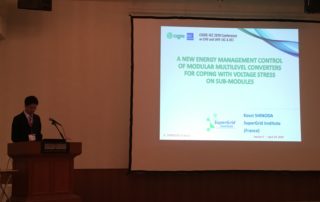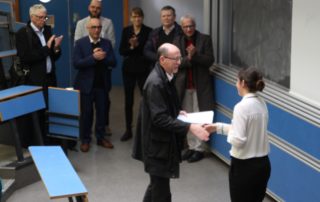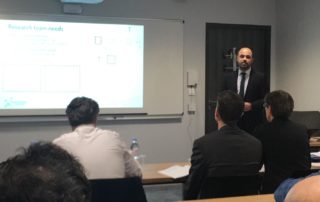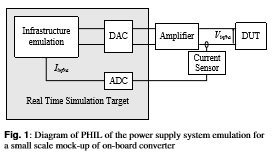Nos actualités
Relive the SuperGrid Institute inauguration
If you would like to re-live your day with us, or if you were unable to attend, we invite you to watch this short video to discover the day’s events and our test platforms & facilities.
SuperGrid Institute presents a brilliant innovation at CIGRE-IEC 2019 in Japan
The Energy Management Control of MMC by SuperGrid Institute was presented in Japan this week at the CIGRE-IEC 2019 Conference on EHV and UHV (AC & DC), generating stimulating discussions about this new technology.
-Phd Caroline STACKLER “Electronic transformers for railway applications”
The main objective of this thesis is to develop a methodology to size PETT topologies, in order to compare them.
PhD Amjad MOUHAIDALI “Contribution to the modelling of HVDC cables for electromagnetic transient simulations”
The integration of new technologies in the electric grids made them more and more complex, and most likely future growth of power grids will be based more on underground cables than overhead lines. One problem here, is that the mathematical model for electromagnetic simulation of power cables still has some shortcomings regarding stability, accuracy and passivity. In this thesis, we evaluate the cable parameters using analytical and numerical methods.
PhD Juan-Carlos GONZALEZ “Transient stability of high voltage AC-DC electric transmission systems”
This thesis addresses the transient stability analysis of hybrid AC/DC electric transmission systems. More precisely two questions sought to be investigated: What is the impact of a DC contingency on AC transient stability? How can we take advantage of the DC transmission systems as control inputs in order to enhance AC transient stability?
Fault behaviour of bipolar overhead line based HVDC grids
This paper provides a fault analysis of bipolar overhead line based HVDC grids using HB-MMC converters. The impacts of fault type and fault resistance are shown and the physical behaviour of the transient fault return current is explained.
Power system stability enhancement via VSC-HVDC control using remote signals: Application on the Nordic 44-bus test system
In this paper the benefits of embedded VSC-HVDC links with supplementary controls for small-signal stability enhancement purposes using remote signals are studied and applied on the Nordic Grid.
SuperGrid Institute and the CNAM have signed a framework agreement
SuperGrid Institute is delighted to have signed a framework agreement with the CNAM (Conservatoire National des Arts et Métiers) regarding training and in particular around supergrid and HVDC technologies. This agreement covers lifelong learning, technology research and the provision for scientific and technical proficiency.
SuperGrid Institute and the CNAM have signed a framework agreement
SuperGrid Institute is delighted to have signed a framework agreement with the CNAM (Conservatoire National des Arts et Métiers) regarding training and in particular around supergrid and HVDC technologies. This agreement covers lifelong learning, technology research and the provision for scientific and technical proficiency.
25 kV-50 Hz railway power supply system emulation for Power-Hardware-in-the-Loop testings
This paper presents a methodology to consider the impedance of a grid in power hardware in the loop (PHIL) experiments to validate power converter control in presence of harmonics or resonances in the network impedance. As the phenomena to emulate are in a large frequency range, the skin effect in conductors has to be taken into account. A procedure is developed to model the network.









